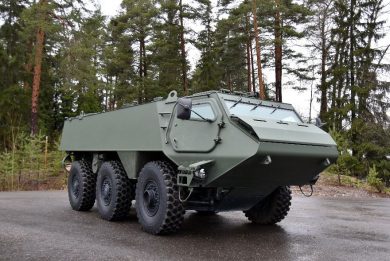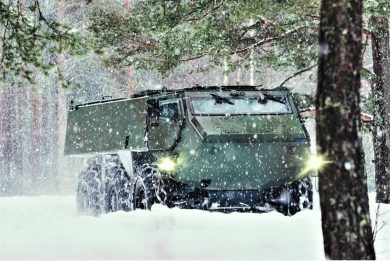Patria back in the sky with its Patria Sky and Patria One drones
When mentioning Patria most people think of wheeled armoured vehicles. In fact, the company history starts over one century ago, when the Finnish Air Force Aircraft Factory was created at Suomenlinna. Patria is still active in the aviation world through various sustainment and aerostructures activities with some 1500 persons working in that area both in Finland and in other European countries. Even though in earlier years Patria’s predecessors had constructed 19 different aircraft designs and built 350 of them, until fall 2024 it did not have a flying product carrying the Patria name. This changed with the acquisition of Nordic Drones Oy, and at the Arctic Event 2025 it was possible to see two Patria flying objects, although of limited dimensions, as maximum take-off mass does not go beyond 10 kg
Patria was in fact involved in the unmanned air systems (UAS) world even before the acquisition of the company based in Muurame, 200 km north of Helsinki. “We have been working since some time in UASs, not producing complete systems, but providing subsystems such as the CANDL data link,” Jukka Holkeri, Executive Vice President of Global Division at Patria told EDR On-Line. The CANDL, the acronym for Compact Airborne Networking Data Link, was installed on Airbus Barracuda UCAV and was recently adopted by Spain for its SIRTAP programme.
“Beside subsystems such as the CANDL, we also had some prototype UAS at the company, but we then decided we needed to have a more comprehensive understanding of drones and UASs, as well as having our own platforms also,” Mr. Holkeri pointed out, adding that “UASs are part of the total solution.” Patria is now capable to provide its customers with its own flying assets integrated in its vehicles, capable to acquire information, transmitting them, and eventually even generate effects on enemy assets.
Launched in October 2024, Patria Drones product portfolio currently features two flying products aimed at military missions, the Patria Sky, a multi-mission UAS, and the Patria One, a tactical UAS.
The Patria Sky
Arriving at the static exhibition during the Patria Arctic Event 2025, the first thing we could notice was a quadcopter high in the sky; it was a Patria Sky, flying over a Patria AMV XP, and in fact it was linked to the 8×8 armoured vehicle by a tether.
In fact the tether option is a new add-on, which is still under testing; the tether station is provided by Elistair, a French company based in Dardilly, close to Lyon, two options being provided, the Light-T 4 and the Safe-T 2, allowing drones to fly respectively at 70 and 100 metres height over the vehicle, the one used during the demo being the Safe-T 2. During the Arctic Event this was seen flying over the vehicle static, the aim being however to have the drone following the vehicle at the same speed, providing a good coverage of the area in front to improve situational awareness and reduce risks. EDR On-Line understood these trials, which started three months ago, have not yet been completed, hence no figure about maximum vehicle speed with the tethered drone flying was available, the maximum speed for the Patria Sky being 22 m/s, which means nearly 80 km/h.
The Patria Sky is a quadcopter made of a near cylindrical body that contains batteries, electronics and carries the payload under its belly. Four legs are fixed to the body to allow stand-off distance from the ground to host the payload, while four arms each one carrying an electric motor at the end are fixed at 90° one from each other. Each motor activates a two-blade 18×6.5-inch carbon fibre propeller with quick locks looking downwards, drone dimensions being 580x580x370 mm, the Lithium-Polymer battery allowing an endurance of up to 64 minutes. When used in free flight mode its controlled operational range is 15 km, a radio link ensuring communications with the SkyControl ground control station which features a 7-inch screen.
Among typical payloads Patria proposes the Nextvision Dragoneye 2, 115 grams day/night optronic gimbal with a 1280×720 resolution day channel with a x40 zoom and a 640×480 LWIR uncooled sensor with a x4 zoom. Capable of static and moving object tracking, detection and classification, the video can be recorded. An optronic payload with higher resolution, 1920×1080 day with x40 optical zoon and x2 digital zoom, and 1280×720 LWIR with x8 optical zoom, known as Nextvision Raptor, both systems being developed by Nextvision, the Israeli company with operations in the US and UK.
In its standard configuration the Patria Sky has a 2.2 kg mass which becomes 4 kg flight ready, with battery, maximum take-off mass being 6.5 kg, which means a 1.5 kg payload capacity. To improve the payload an XL kit is available, with new arms, motors, and rotors. The arms are longer and carry a more powerful motor that activates a 22×7.0-inch propeller without quick locks, dimensions of the ready to fly UAS being 660x660x370 mm. The mass ready to fly increases to 4.4 kg, however the maximum take-off mass is increased to 9.4 kg, meaning a 5 kg payload.
The Patria One
The Patria One is also a quadcopter but it has a pretty different configuration; it features a flatter body, the legs are fitted at the end of the arms, under the electric motors, and the two-blade 18-inch rotors are located on top of the motors, hence there are pulling propellers. Without propellers the Patria One dimensions are 620x620x310 mm, while with propellers the diameter is 1,245 mm. Maximum take-off mass is 7 kg, the airframe having a mass of 2 kg, to which we must add 0.7 kg of the battery, maximum payload being considered 4 kg. Transported in a tactical pack, it is ready to fly in two minutes, all elements being fitted with quick mounts. The Patria One can fly at a maximum speed of 24 m/s (86+ km/h), endurance being 14 minutes, the range with maximum payload being 7.5 km, which increase to 10 km with a 1.5 kg payload. Navigation is ensured by an inertial measuring unit and a GNSS receiver that operates with GPS/Galileo, Glonass and Beidous signals, an encrypted data link ensuring command link as well as video streaming.
The Patria One can carry different payloads, but it is mostly used as a First Person View drone, capable to neutralise enemy assets. At the Arctic Event we could see it with two different payloads, both painted blue to indicate they were inert.
One was a cylindric body containing a shaped charge capable to generate an EPF (Explosively Formed Penetrator), the charge being initiated when the drone flies over the intended target. To precisely aim the Patria One is fitted with a Strike Systems Pro-Optic red dot sight through which the tilt camera installed over the sight can look in the last instants of the attack mission, providing the image to the operator, the Patria One being operated by the same SkyControl ground station used for the Patria Sky.
A second option is available, a system allowing to drop ordnance over the target, i.e. mortar bombs. This will make the airframe reusable, while in the other two options the mission will be one-way only. In all cases a three-step safety system is fitted for operator safety. This option was not showcased in Lapland.
The third one, which EDR On-Line understood is currently only a concept and not a ready product, was the warhead used on Dynamic Nobel Defence Panzerfaust 3 antitank rocket launcher; it has a mass of around 6 kg hence, to carry it, the XL version of the Patria One should be used, which is obtained using the same XL kit used on the Patria Sky, the diameter footprint with propellers increasing to 1,450 mm. In this case the Patria One would attack horizontally, in order to properly detonate the shaped charge towards the vehicle armour.
At the Arctic Event the Patria One Fast was also visible, which features shorter arms, three-blade propellers, and ha a maximum payload of 3 kg,
The Patria One was designed to be inexpensive and allow easy mass production, Patria saying that it can be manufactured in “tens of thousands” per year without providing further details.
Photos by P. Valpolini












